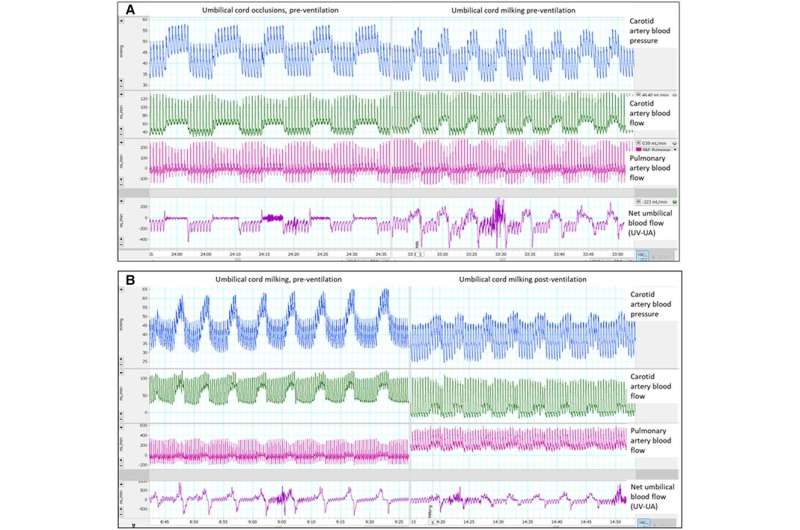This article has been reviewed according to Science X's editorial process and policies. Editors have highlighted the following attributes while ensuring the content's credibility:
fact-checked
trusted source
proofread
Study: Safety concerns eased over umbilical cord milking

Safety concerns have been eased over a potentially life-saving method of umbilical cord clamping for newborn babies, thanks to research at Hudson Institute.
Umbilical cord milking is a technique that is frequently used to help provide additional blood to newborn babies before the cord is clamped and cut.
Professor Stuart Hooper works with Monash Children's Hospital and Monash University on better ways to protect vulnerable newborns, especially those born preterm, who have trouble taking their first breaths.
Benefits umbilical cord clamping delay
His team has already established that delaying cord clamping can have beneficial effects on heart function and blood pressure, reducing the likelihood of damage to the brain and lungs.
"However, if clamping occurs too early, heart function markedly decreases and blood pressure rapidly increases," Hooper said.
"If cord clamping is delayed, the infant can also receive a beneficial blood transfusion from its placenta, but this can take a few minutes."
Some clinicians believe the blood transfusion can be sped up by squeezing the umbilical cord and forcing blood to move from the placenta into the baby—a process called umbilical cord milking.
Research explains cord clamping blood pressure surge
"We have previously shown that umbilical cord milking at birth can cause large blood pressure surges that increase the risk of severe brain hemorrhage, particularly in very immature preterm infants; our latest study explains why," Hooper said.
"It appears that after the infant starts breathing, the lungs can act as a 'pressure release valve' which greatly suppresses blood pressure surges caused by cord clamping or cord milking" he said.
"We have now shown that if cord milking occurs after the infant has had the opportunity to breathe, the blood pressure surges are greatly reduced, which lowers the risk of brain hemorrhage."
With umbilical cord milking increasingly becoming common practice, Hooper says these findings provide the scientific basis for the recent clinical recommendation that very immature preterm infants should not receive umbilical cord milking. The research is published in the journal Frontiers in Pediatrics.
What is umbilical cord milking?
Umbilical cord milking is a procedure that involves squeezing or "milking" the umbilical cord after the baby is born. This is done to help transfer blood from the placenta to the baby.
The idea is that by increasing the amount of blood flow to the baby, it can help prevent the health issues that can result from oxygen starvation after birth.
However, it is not always recommended and should be discussed with a health care provider before considering it.
More information: Douglas A. Blank et al, Lung aeration reduces blood pressure surges caused by umbilical cord milking in preterm lambs, Frontiers in Pediatrics (2023). DOI: 10.3389/fped.2023.1073904



















